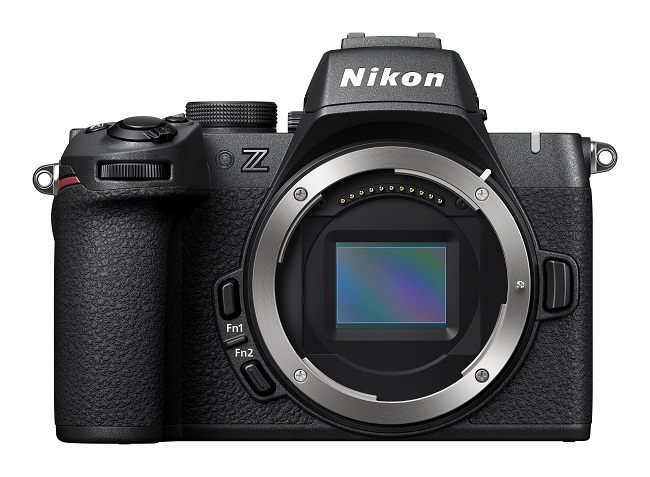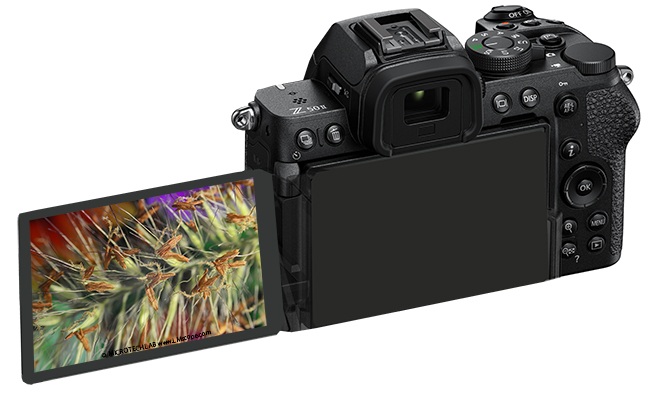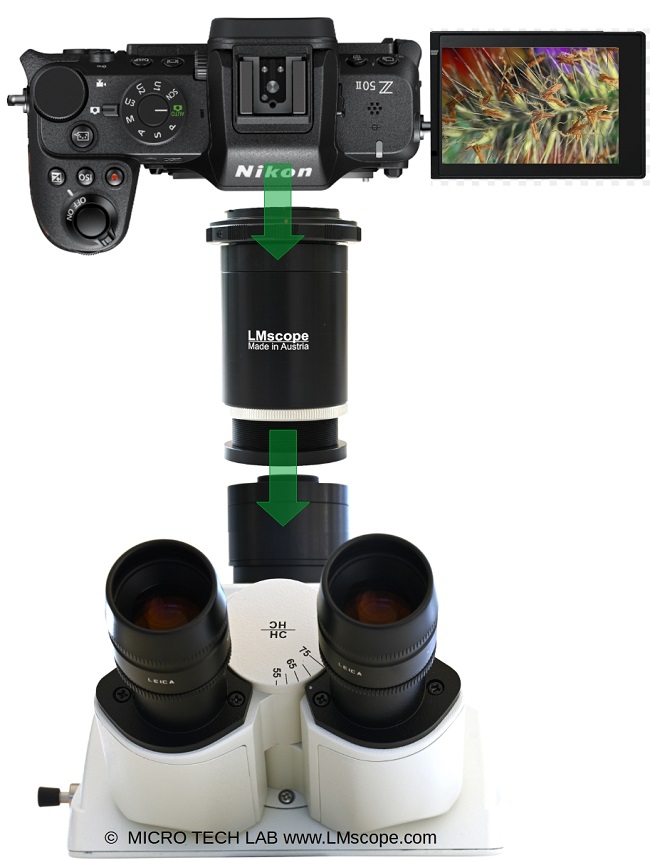

Nikon Z50 II: a high-performance mirrorless microscope camera with APS-C sensor
With a powerful, large image sensor, cutting-edge camera technology, useful features and high-performance software, the Z50 II is a genuine alternative to conventional C-mount microscope cameras.
Nikon launched the Z50 II in November 2024 as a successor to its Z50. Positioned in the mid-range price bracket, the Z50 II also excels as a high-performance microscope camera. When used to capture images from a microscope, its large, high-grade APS-C sensor delivers excellent photo and video material. On top of that, the Z50 II is easy to use and comes equipped with a suite of useful features (live streaming, webcam mode, 4K video…). Because it is produced in large quantities, this camera has a very attractive price point (approx. EUR 980 as of 2024).
With our LM microscope adapters, which feature integrated precision optics, the Z50 II can be attached to virtually any microscope – either via the phototube or the eyepiece tube.
The Z50 II combines premium build quality and state-of-the-art camera technology, which makes working with the microscope easier and more efficient. The image sensor is highly light sensitive and also features a wide dynamic range, making the Z50 II a real alternative to conventional C-mount microscope cameras, which often only have a very small image sensor. Unlike these, the Z50 II can also be operated autonomously, without connection to a computer.

Photo: Nikon
Below are the key tech specs of the Nikon Z50 II:
- 20 MP APS-C (23.6 mm x 15.8 mm) CMOS imaging sensor
- Movie recording frame size (pixels) and frame rate: 3,840 x 2,160 (4K UHD); 60p
- 4K video with 5.6K oversampling at 30p
- no maximum video recording time of 30 minutes
- Nikon Z mount
- 3.2'' / 8 cm vari-angle TFT touch-sensitive LCD screen
- ISO 100 to 51,200 (automatic mode) and up to 204,800 (manual mode)
- Up to 11 fps shooting at the highest resolution, 15 fps with electronic shutter
- Pre-release-capture up to 1 second
- USB-C 3.2 for continuous power supply (NEW!) and charging, streaming and data transfer
- UVC video signal for live streaming and video recording
- Webcam function
- HDMI micro out terminal (type D) with output of 3,840 x 2,160 (4K) 30p
- Built-in Wi-Fi (wireless LAN), Bluetooth technology
- 4K photo during video recording
- 4K time-lapse recording
- Video recording with N-Log
- SD (UHS-II) memory card
- Weight: 550 g (body only), larger body than its predecessor
- New, more powerful Expeed 7 dual image processor (improved image quality at high ISO sensitivities)
The Z50 II is equipped with a vari-angle screen with a resolution of 1 megapixel, allowing for optimal positioning. An external, high-resolution monitor in 4K mode can be connected to the camera via HDMI cable for live image transfer, benefiting from the camera’s Clean HDMI mode, which allows for lossless transfer of video information to an external monitor or HDMI recorder without any quality degradation.

The Z50 II can also be connected to a computer via USB cable. With Nikon’s Camera Control Pro 2 software, the camera can be conveniently controlled remotely from a computer in Live View, and the camera settings can be adjusted as well, which makes working with the microscope considerably easier. The Z50 II also has USB charging, ensuring a continuous power supply for extended use.
The new Expeed 7 image processor, previously only used in higher-priced full frame cameras, is reportedly six times faster than its predecessor and delivers exceptional image quality.
N-Log recording offers more flexibility when editing footage for colour and contrast in post-production. Because N-Log preserves more information in the image than is visible in a standard profile, it allows photographers to enhance small details or reveal hidden structures, boosting the dynamic range of the camera’s image sensor to up to 12 stops.

The Nikon Z50 II is attached to the C-mount connection of the microscope or the microscope’s eyepiece tube using an LM microscope adapter with integrated precision optics. Especially in professional microscope imaging applications, operating the camera remotely from the computer is the recommended option. With Nikon’s Camera Control Pro 2 software, the camera settings and shutter release can be controlled quickly and effortlessly, which significantly improves workflow efficiency.
15.11.2024Photography:
Fitting the microscope to digital single-lens reflex (DSLR), mirrorless interchangeable-lens cameras (MILC ), digital single-lens mirrorless (DSLM) or C-mount cameras is easy with our LM digital SLR adapters, which feature a plan achromatic optical system. Our products make it possible to capture top-quality microscope images. To help you select the adapter that is right for your camera, we have set up an online configurator on our website. You can also email us – ideally with attached photographs of your microscope.
Modern DSLR and single-lens mirrorless (DSLM) offer the latest technology and are generally very well suited for microscopy applications. Most of them can be controlled remotely via PC/Mac. Because of their high sales volumes, they offer an excellent price/performance ratio compared to special-purpose microscope cameras.
Features of top DSLR and single-lens mirrorless cameras (DSLM):
- Large, powerful full-frame sensors (36 x 24 mm)
- Sensor resolution of 61 megapixels or 240 megapixels with Pixel Shift technology
- High light sensitivity (ISO 400,000+)
- Extensive dynamic range (up to 15 aperture stops/f-stops)
- Short exposure times (1/8000 second) up to 1/32,000 seconds using the digital shutter
- 4K Ultra HD or 8K Ultra HD video function
- Live video capture on external monitors in ultra HD quality
In most cases, these cameras are significantly more powerful than microscope cameras with smaller sensors (1/2" or 2/3"). On our website you will find our current camera recommendations and a camera ranking which is specifically tailored to microscopy applications.